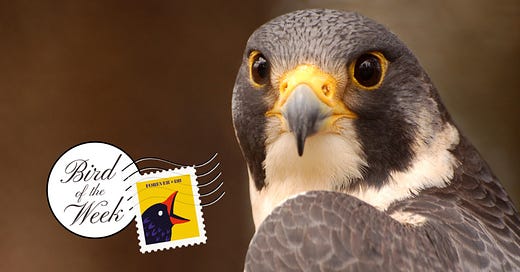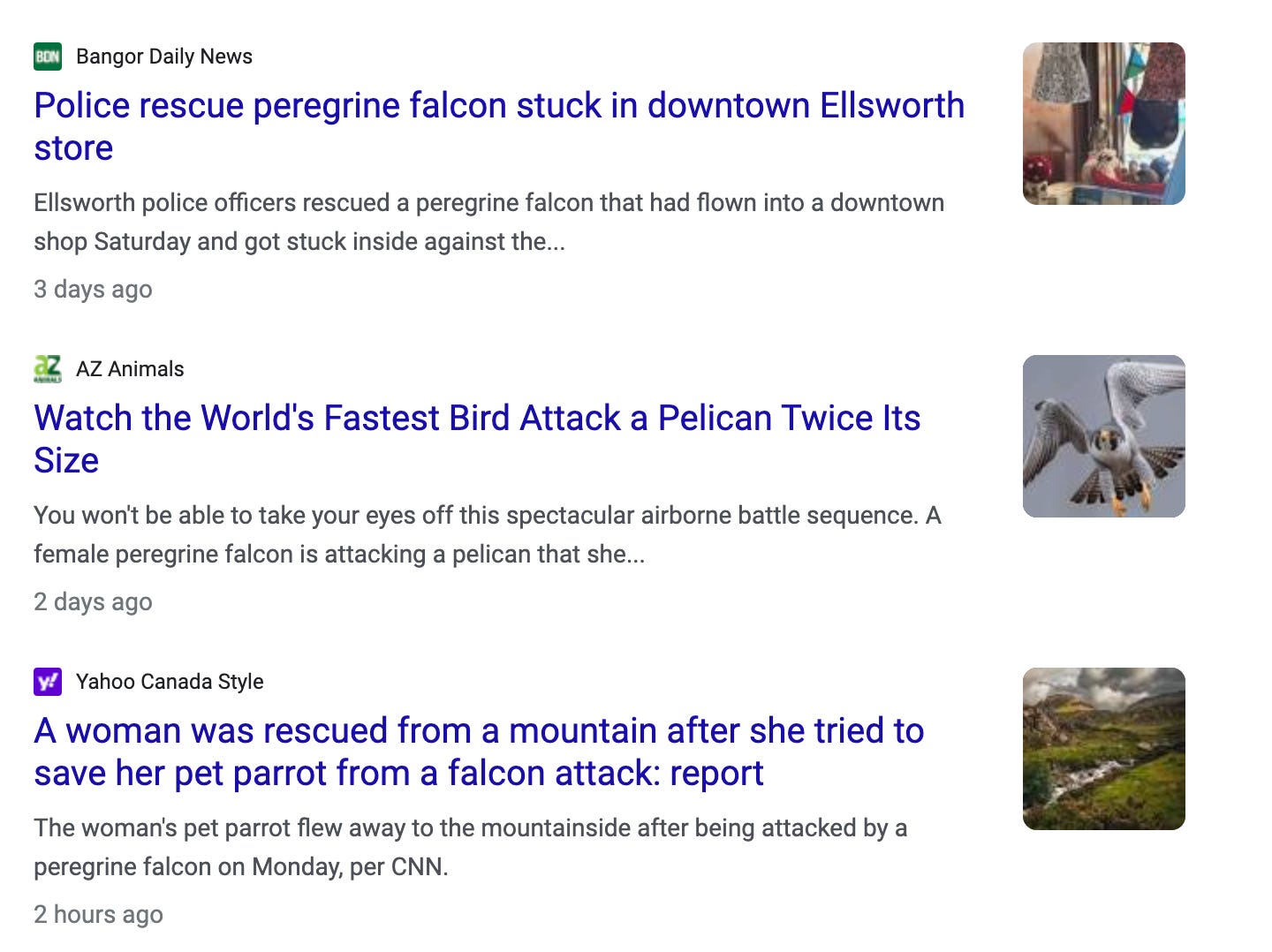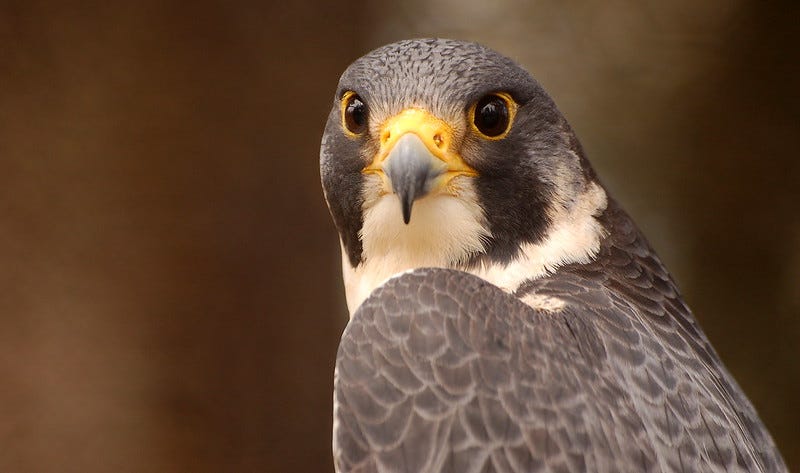Bird of the Week: Peregrine Falcon
When people say "legends only," this is what they're talking about.
Here at Bird of the Week, we take great pride in being a place that celebrates all birds, all the time, with only a minimal amount of squabbling over which birds reign supreme.
(Sidebar: Thinking about “all birds” led me to Google exactly how many birds “all birds” is and apparently there are 18,000 bird species in the world and between 50 and 430 billion individual birds worldwide. Holy smokes!!! Something to think about next time you’re high.)
Anyway, despite kneeling at the altar of avian species worldwide, we had a minor moment of hesitation when it came to choosing this particular entry in our Falcon Month—yes it’s Falcon Month!—pantheon. It’s a bird that’s so obvious, maybe it’s borderline too obvious? But there’s another word for that, my friends: iconic.
That’s right. This week, we’re going all in on the Peregrine Falcon. It’s a legend for a reason!!
Okay yes, it’s factually true that the peregrine falcon is among the world's most common birds of prey—they literally live on every continent except Antarctica, and many oceanic islands. But don’t let their ubiquity or ordinary status fool you. Peregrine falcons might be common, but they’re uniquely rad as hell.
There’s really no point in messing around here, so let’s just get to the fireworks. Peregrine falcons are most known for one thing: they’re unbelievably, mind-bogglingly fast. Their diving speed during flight can reach up to 200 miles per hour (TWO HUNDRED MILES PER HOUR), which makes them not only the fastest bird in the world but the world’s fastest animal overall. Wowee zowee, that’s a pretty incredible claim to fame.
If you want to know what that might feel like, check out the video below. It’s kind of barf-inducing! Those with a need for speed might be appealing, but uh, I’m personally gonna leave this one to the birds.
Thank god for the video honestly, because I’m not sure how I could possibly begin to articulate how incredible the peregrine falcon moves in the air or how astounding that speed is. That said, I had a helluva good time reading the many, many descriptions online that aim to capture the awe we should all be feeling about these beasts. This is what overly-verbose and flowery descriptions were made for! Words like “grace,” “agility,” and “beauty,” dovetail with “skillful,” “powerful,” “noble,” and “spectacular.” No lies detected!
Naturally, peregrine falcons are also extremely hardcore. These strong, big, and supremely fast birds hunt their prey by diving down and delivering a swift blow to their targets (often in midair!) so the poor victims basically never even knew what hit ‘em.
Those aerial executions are perhaps indicative of the peregrine falcon’s affinity for drama and stunts (are these birds the Tom Cruises of the sky??), but they also make sense for a bird whose diet largely consists of…other birds. While peregrine falcons sometimes dabble in small rodents and other insects, they mostly feed on ducks, songbirds, shorebirds, and in urban locales, starlings (GASP) and pigeons. They love all the birds just like we do! Nice to have that in common.
Peregrine falcons tend to settle in a wide variety of habitats, often near water on ledges and cliffs, though some also inhabit city skyscrapers or tree nests built by other bird species. The one thing they seem to love above all else is open spaces, and the word "peregrine" actually means "wanderer," “traveler,” or "pilgrim.” These dudes love to roam the earth, delight in aerial acrobatics, and do it all while casually holding the title of fastest animal ever.
While they cannot be contained spiritually, peregrine falcons have a long history of being used in the sport of falconry. Humans have been training falcons for over a thousand years. Also not for nothing, the blue-gray feathers and yellow accents on a peregrine falcon make it look like it’s wearing a freaking uniform or superhero costume. How is this animal not the mascot for every sports team ever?? So effortlessly cool.
After their record-breaking speed, the second thing that most people know about peregrine falcons is that they’re goddamn survivors. The species was almost wiped out entirely in the mid-20th century, due to the devastating effects of DDT and pesticides on their eggshells. After those chemicals were banned, peregrine falcon populations rebounded completely and it’s no longer listed as an endangered species. The peregrine falcon now serves as a symbol among conservationists (and more broadly) of the recovery that can be possible for endangered species, if we’re willing to take action on their behalf.
Okay, I could go on, but I’d be remiss if I didn’t mention one final thing that really solidifies the peregrine falcon as That Girl. It’s in the news constantly! Just look at the stories from this week alone:
Peregrine falcons: They’re fast, they’re scary, they lived bitch, and they’re out here mixing it up on a daily basis. That’s what makes them one of the greats.
A reminder: you can check out our complete Bird of the Week list here, and get in touch with your bird suggestions at hello@discourseblog.com.










For those of us of a certain age, at least, interest in the peregrine falcon was spurred by reading My Side of the Mountain. There was one that was in the news for nesting by the window of an office building in Baltimore, and I was able to go with my mom and take pictures.
BASEBALL COVERED IN RAZORBLADES. BASEBALL COVERED IN RAZORBLADES... BASEBALL COVERED IN RAZORBLADES!